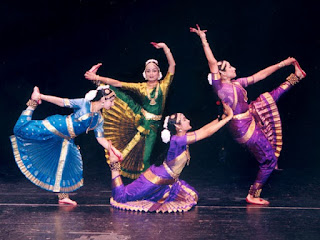1.DR. PADMA SUBRAHMANYAM

 The most famous bharathanatyam dancer is ,Dr. Padma Subrahmanyam, is an Indian classical Bharata Natyam dancer. She is also a research scholar, choreographer, music composer, musician, teacher and author.She is famous in India as well as abroad: several films and documentaries have been made in her honor by countries like Japan, Australia and Russia.Padma Subrahmanyam was born to Directer Subrahmanyam and Meenakshi Subrahmanyam.Her creativity as dancer and choreographer includes expansion of the technique through the use of the entire body with leaps and extension of legs and fast footwork for ramification of rhythm. Padma has revived mono-acting technique (Banika style) through Krishnaya Tubhyam Namaha, Ramaya Tubhyam Namaha, Jaya Jaya Sankara and other productions. She has given several solo and group presentations (including dance dramas) such as Meenakshi Kalyanam, Viralimalai Kuravanji, Valli Kalyanam, Silappadikaram, Krishna Tulabaram, Parijata Aharanam, Nagarukku Appal, Geetanjali, Shyama, Sri Gurave Namaha, Pavai Nombu, Vande Mataram (specially produced for the Golden Jubilee of India's Independence) and so on.
The most famous bharathanatyam dancer is ,Dr. Padma Subrahmanyam, is an Indian classical Bharata Natyam dancer. She is also a research scholar, choreographer, music composer, musician, teacher and author.She is famous in India as well as abroad: several films and documentaries have been made in her honor by countries like Japan, Australia and Russia.Padma Subrahmanyam was born to Directer Subrahmanyam and Meenakshi Subrahmanyam.Her creativity as dancer and choreographer includes expansion of the technique through the use of the entire body with leaps and extension of legs and fast footwork for ramification of rhythm. Padma has revived mono-acting technique (Banika style) through Krishnaya Tubhyam Namaha, Ramaya Tubhyam Namaha, Jaya Jaya Sankara and other productions. She has given several solo and group presentations (including dance dramas) such as Meenakshi Kalyanam, Viralimalai Kuravanji, Valli Kalyanam, Silappadikaram, Krishna Tulabaram, Parijata Aharanam, Nagarukku Appal, Geetanjali, Shyama, Sri Gurave Namaha, Pavai Nombu, Vande Mataram (specially produced for the Golden Jubilee of India's Independence) and so on.
ACHIEVEMENT AND AWARDS
Twelve years after completing her design of these 108 Karana figures, she discovered by the grace of the sage of Kanchi, about 50 Karana sculptures in the world-renowned monument temple complex at Prambanan in Central Java, Indonesia belonging to the 9th century AD.
2.ALARMEL VALLI
 Alarmel Valli is an Indian classical dancer and chreographer. Born September 14, 1956, Valli is the founder of Dipashikha, a centre for fine arts in Chennai, established in 1984, where she teaches Bharatanatyam, is the foremost exponent of the Pandanallur style dance form of Bharatanatyam. She was the youngest dancer to be conferred the President award of Padma Shri in 1991. She was also awarded the Sangeet Natak Akademi Award in 2001 and the Padma Bhushan in 2004.Alarmel Valli was born and brought up in Chennai, where she did her schooling from The Sacred Heart Matriculation School, at Church Park, Chennai and later studied at the Stella Maris College, Chennai. She trained in the Pandanallur style of Bharat Natyam under Pandanallur Chokkalingam Pillai and his son Subbaraya Pillai. She studied music under T. Muktha, of the Veena Dhanammal style of music for many years.
Alarmel Valli is an Indian classical dancer and chreographer. Born September 14, 1956, Valli is the founder of Dipashikha, a centre for fine arts in Chennai, established in 1984, where she teaches Bharatanatyam, is the foremost exponent of the Pandanallur style dance form of Bharatanatyam. She was the youngest dancer to be conferred the President award of Padma Shri in 1991. She was also awarded the Sangeet Natak Akademi Award in 2001 and the Padma Bhushan in 2004.Alarmel Valli was born and brought up in Chennai, where she did her schooling from The Sacred Heart Matriculation School, at Church Park, Chennai and later studied at the Stella Maris College, Chennai. She trained in the Pandanallur style of Bharat Natyam under Pandanallur Chokkalingam Pillai and his son Subbaraya Pillai. She studied music under T. Muktha, of the Veena Dhanammal style of music for many years.She made her stage debut at an early age of 9 1/2 under the auspices of Indian Institute of Fine Arts, Madras and was conferred the Natya Kala Bhushan award and won her laurels on the International scene when she was barely 16 at the International Dance Festival of Theatre organised by the prestigious Sarah Bernhardt Théâtre de la Ville, in Paris, and has been performing ever since, both in India and aboard.She also learned Odissi under Guru Kelucharan Mohapatam and his disciple Guru Ramani Ranjan Jena, and studied classical Tamail litrerature anthologies of the 2000 years old, Sangam poetry. Over the years she has gradually evolved her own distinct style that extended her tradition within the broad framework of classical Bharatanatyam.
ACHIEVEMENT AND HONORS
- 1969:The title of “Natyakalabhushanam” from the Indian Fine Arts Society.
- 1985: Nritya Choodamani, from the Krishna Gana Sabha (Madras).
- 1991: Padma Sri[11]
- 2004: Padma Bhushan
- 2004: Chevalier of Arts and Letters award from the French Government[2][




























